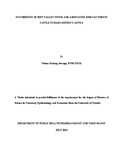| dc.description.abstract | Ijara district in Kenya was one of the hotspots of Rift Valley Fever (RVF) during the 2006/2007 outbreak which led to human and animal deaths causing huge economic losses. The main constraint in the control and prevention of RVF is inadequate knowledge on its occurrence during the interepidemic period. This study was aimed at understanding the occurrence of RVF and perceived risk factors by pastoralists in cattle in Ijara to enable the development of improved community-based disease surveillance, prediction, control and prevention. Six herds of 700 to 1000 cattle were identified and one animal tagged with Global Position System (GPS) collar to enable follow up during sero-surveys as well as understanding the herd‟s movement through various ecological zones. Sixty animals under 3 years from each herd were randomly selected during each sero-survey and sero-surveyed for RVF four times (September 2012, December 2012, February 2013 and May 2013) during the study period. Serum samples collected were subjected to RVF inhibition ELISA test to detect if there was exposure for RVF Virus (RVFV). The positive samples to RVF inhibition ELISA were subjected to IgM ELISA test to determine if the exposures were current (within 14 days). Thirty one key informant interviews were also conducted with relevant stakeholders to determine the local pastoralists‟ understanding of risk factors and risk pathways of RVF in cattle in Ijara district.
The result of the survey indicated that 13.1% (183/1396) of cattle sero-surveyed had RVFV antibodies under inhibition ELISA test while 1.2% (18/1396) of the cattle was positive when subjected to IgM ELISA. This clearly indicated that RVFV was in circulation in cattle in Ijara
district even during the interepidemic period. On the other hand, the respondents interviewed rated the high presence of mosquitoes, availability of large herds of cattle and once in a while high rainfall leading to floods in the relatively flat land of the region to be the main risk factors. Close contact between wildlife and cattle was suggested to be another main risk factor for occurrence of RVF. The main risk pathways were infected mosquitoes that bite cattle while grazing and at watering points as well as the close contact between domestic animals and wildlife. The likelihood of contamination of the environment due to poor handling of carcasses and aborted foetuses during RVF outbreaks was not considered an important pathway. The mobility of the cattle in search of pasture suggested the likelihood of infection transfer over a wide area. The findings pointed that low rainfall within Ijara was able to maintain the circulation of RVFV in Ijara region with the ability to become an epidemic if the rainfall increased to cause extensive floods. As a result there is need to carry out regular participatory disease surveillance in domestic animals, vectors, human population and wildlife while carrying out community awareness as well as vaccination campaigns against RVF for preparedness, prevention and control of any possible epizootics. Additionally, monitoring of environmental conditions to detect enhanced rainfall and flooding should be prioritized for preparedness. | en_US |

